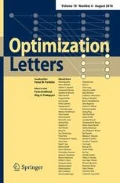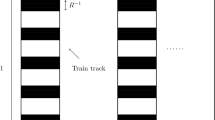Abstract
By introducing redundant Klee–Minty examples, we have previously shown that the central path can be bent along the edges of the Klee–Minty cubes, thus having 2n−2 sharp turns in dimension n. In those constructions the redundant hyperplanes were placed parallel with the facets active at the optimal solution. In this paper we present a simpler and more powerful construction, where the redundant constraints are parallel with the coordinate-planes. An important consequence of this new construction is that one of the sets of redundant hyperplanes is touching the feasible region, and N, the total number of the redundant hyperplanes is reduced by a factor of n 2, further tightening the gap between iteration-complexity upper and lower bounds.
Similar content being viewed by others
References
Dantzig G.B. (1951). Maximization of a linear function of variables subject to linear inequalities. In: Koopmans, T.C. (eds) Activity Analysis of Production and Allocation, pp 339–347. Wiley, New York
Deza A., Nematollahi E., Peyghami R. and Terlaky T. (2006). The central path visits all the vertices of the Klee–Minty cube. Optimiz Meth. Softw. 21(5): 851–865
Deza, A., Nematollahi, E., Terlaky, T.: How good are interior-point methods? Klee–Minty cubes tighten iteration-complexity bounds. Math. Programm (to appear)
Deza, A., Terlaky, T., Zinchenko, Y.: Central path curvature and iteration-complexity for redundant Klee-Minty cubes. In: Gao, D., Sherali, H. (eds.) Advances in Mechanics andMathematics. Springer, Heidelberg (to appear)
Karmarkar N.K. (1984). A new polynomial-time algorithm for linear programming. Combinatorica 4: 373–395
Khachiyan L.G. (1979). A polynomial algorithm in linear programming. Sov. Math. Dokl. 20: 191–194
Klee V. and Minty G.J. (1972). How good is the simplex algorithm?. In: Shisha, O. (eds) Inequalities III, pp 159–175. Academic, New York
Meggiddo, N.: Pathways to the optimal set in linear programming. In: Meggiddo, N. (ed.) Progress in Mathematical Programming: Interior-Point and Related Methods. Springer, Heidelberg, pp.131–158 (1988); also in: Proceedings of the 7th Mathematical Programming Symposium of Japan, Nagoya, Japan, pp. 1–35 (1986)
Roos C., Terlaky T. and Vial J.-Ph. (2006). Theory and Algorithms for Linear Optimization: An Interior Point Approach, 2nd edn. Springer, New York
Sonnevend, G.: An “analytical centre” for polyhedrons and new classes of global algorithms for linear (smooth, convex) programming. In: Prékopa, A., Szelezsán, J., Strazicky, B. (eds.) System Modelling and Optimization: Proceedings of the 12th IFIP-Conference. Budapest 1985. Lecture Notes in Control and Information Sciences, vol. 84. Springer, Heidelberg, pp. 866–876 (1986)
Terlaky T. and Zhang S. (1993). Pivot rules for linear programming—a survey. Ann. Oper. Res. 46: 203–233
Todd M. and Ye Y. (1996). A lower bound on the number of iterations of long-step and polynomial interior-point linear programming algorithms. Ann. Oper. Res. 62: 233–252
Vavasis S. and Ye Y. (1996). A primal-dual interior-point method whose running time depends only on the constraint matrix. Math. Programm. 74: 79–120
Ye Y. (1997). Interior-Point Algorithms: Theory and Analysis. Wiley-Interscience Series in Discrete Mathematics and Optimization. Wiley, New York
Author information
Authors and Affiliations
Corresponding author
Rights and permissions
About this article
Cite this article
Nematollahi, E., Terlaky, T. A simpler and tighter redundant Klee–Minty construction. Optimization Letters 2, 403–414 (2008). https://doi.org/10.1007/s11590-007-0068-z
Received:
Accepted:
Published:
Issue Date:
DOI: https://doi.org/10.1007/s11590-007-0068-z




